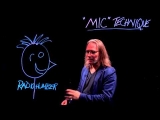MIDI.m4v
MIDI.m4v
The original analog sequencers for synthesizers managed only control voltages, that changed the pitch of the oscillators and filters , and gates, that controlled the envelope generators. They were generally simple rows of manual potentiometers that were not computer controlled. Then Dave Smith, an audio engineer and designer for the synthesizer manufacturer Sequential Circuits, thought that it should be possible for all synthesizers and sequencers to “talk” to each other. Smith was able to successfully demonstrate to the Audio Engineering Society, how his Prophet 600 synthesizer and a Roland JP-6 sequencer could is an acronym for Musical Instrument Digital Interface, and based on Smith’s research, the MIDI spec was published in 1983. It standardized synthesizer and synth peripherals, so that now, many different synthesizers could be controlled from a single keyboard. Also, after the MIDI specs were adapted into software, computer sequencers could now at last, record and edit MIDI performances.















